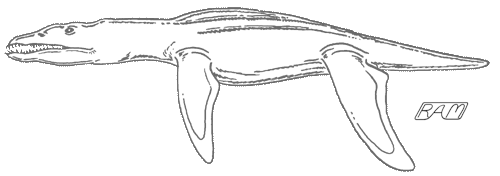Giants: Liopleurodon ferox
Maximum Length = 56 feet (17 metres)
Maximum Weight = 12 tonnes (12 tons)?

This giant pliosaur (short-necked plesiosaur) was one of the largest predators our planet has ever produced. Despite over-enthusiastic estimates by the BBC Television series, Walking With Dinosaurs that Liopleurodon may have reached lengths of 25 m (80 feet), the largest known specimens suggest a maximum length of 17 m (56 feet). Liopleurodon lived about 160 to 155 million years ago in what are now England and Germany (and possibly Mexico) and fed upon other marine reptiles, such as ichthyosaurs, as well as large fish and belemnites (straight-shelled cephalopods). With a 3-m (10-foot) crocodile-like head armed with dagger-like teeth and a sealion-like body, Liopleurodon must have been the late-Jurassic equivalent of the modern Killer Whale (Orcinus orca). A recently discovered but, as-yet unnamed, fossil ichthyosaur may have been even larger than Liopleurodon. Discovered in 1991 near the Sikanni Chief River of British Columbia, Canada, the fossil unearthed by Elizabeth Nicholls and her team, measures some 23 m (75.5 feet) in length — the skull alone was 5.8 m (19 feet) long. Like other ichthyosaurs, this un-named giant was probably an active predator.
